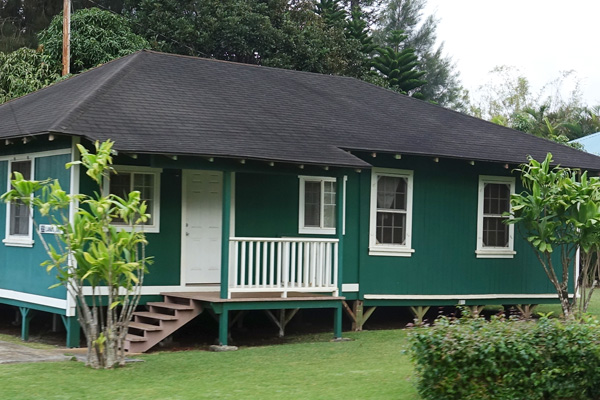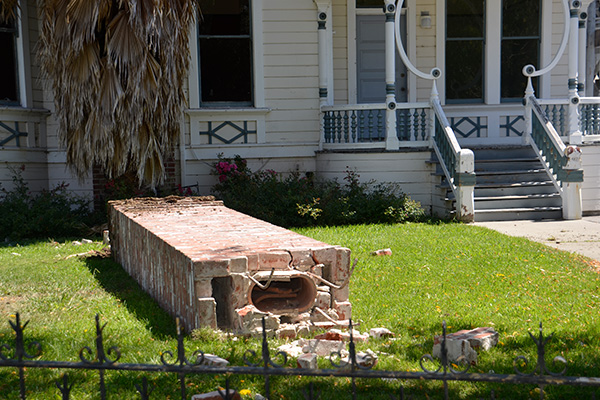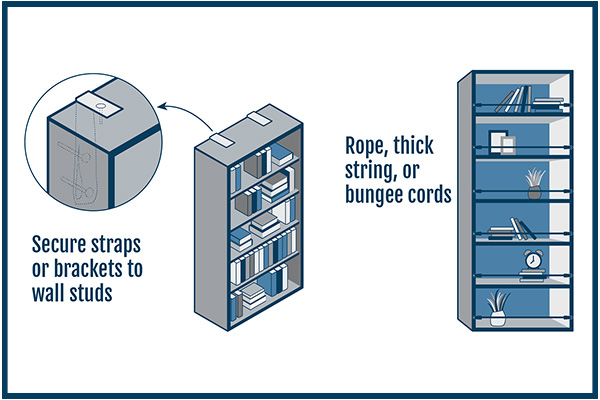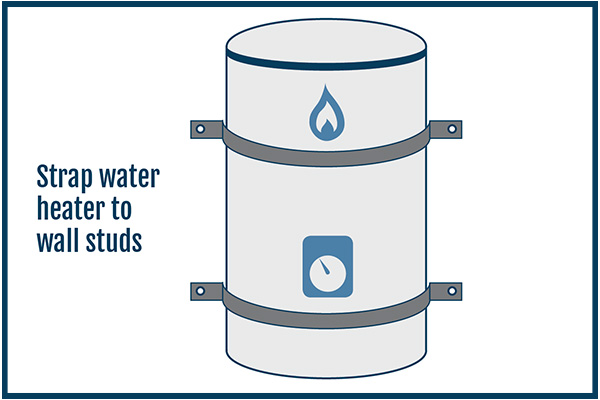There are more than 500 active faults in California and most Californians live within 30 miles of an active fault. Scientists predict a greater than 99% chance of one or more magnitude 6.7 or greater earthquakes hitting our state.* With all this seismic activity, it’s not a matter of if an earthquake will strike—just a matter of when.
While no one can predict when an earthquake will strike, you can prepare by strengthening your home with a seismic retrofit. Seismically retrofitting a house makes it more resistant to earthquake damage. Earthquakes are inevitable in California, and seismically retrofitting your house is possibly the greatest investment you can make to keep your family safe and protect your biggest financial asset from quake damage.
Top 11 Tips for Earthquake Retrofitting Your Home
Here are the top tips to seismically retrofit your home and protect your family from earthquake damage.
1. Identifying Earthquake Vulnerabilities in Your Home
Different types of houses may be vulnerable to earthquake shaking due to their unique structure or design. It's crucial to understand what kind of home you live in and identify what parts of your home are most at-risk from earthquake damage. Common weak points include unbraced cripple walls, post and pier foundations, soft-story structures, and steep slopes. These elements of your home may need earthquake retrofitting to make them more resistant to earthquake forces. Understanding your house type and identifying potential vulnerabilities is the first step in creating a seismic retrofit plan for your home.
2. Brace and bolt your raised foundation home
Brace and bolt your raised foundation home by reinforcing the short walls (cripple walls) between the foundation and the first floor and anchoring the house to the foundation.
If you have steps leading up to the front door of your home, it’s likely you have a raised foundation home. If you have an older home, i.e. one built before 1980, the walls surrounding the crawl space beneath the first floor (called cripple walls) might need to be braced and/or bolted to the foundation. Ground shaking from an earthquake can cause an unbraced and unbolted house to slide or fall off its foundation, leading to catastrophic damage. Bracing cripple walls and bolting them to the foundation with anchor bolts can help prevent them from collapsing and help protect the rest of the house from sliding or toppling off the foundation. Bracing and foundation bolting your raised foundation home is one of the most important steps you can take to seismically retrofit your house.
3. Strengthen your soft-story walls
Strengthen your soft-story walls, such as the walls of a garage with a living space over them, by bolting the structure to the foundation, reinforcing the walls with plywood, and reinforcing your garage door with a brace.
The 1989 Loma Prieta earthquake showed how vulnerable soft story homes are to earthquake damage. Many of the housing units that collapsed or were damaged in that quake were soft-story. Strengthening your soft-story walls is a crucial step to help make your home more resilient against an earthquake. Soft-story structures, such as garages with living spaces above, are especially vulnerable to collapse during quakes because they are large open spaces with unbraced walls and often have large doors that are not retrofitted to withstand ground shaking. Depending on several factors, soft story retrofits may involve bracing garage door openings, back walls, side walls, and floor framing. These steps can help protect your soft-story home from damage or collapse during a quake.
4. Reinforce your post and pier foundation home
Reinforce your post and pier foundation home by adding a continuous concrete footing around the crawl space and reinforcing the crawl space with plywood.
Post and pier foundation homes are often vulnerable to earthquake damage because they don’t have a continuous concrete foundation. Instead, the entire weight of the home is supported by wooden posts resting on concrete blocks, or concrete piers set into the ground. Ground shaking can cause these types of homes to shift and collapse. This type of retrofit involves adding a continuous concrete footing around the crawl space and then adding plywood bracing on new crawl space wall studs all around the crawl space. This creates a stronger connection between the foundation and the house, distributes the weight of the house more evenly, and helps to prevent it from shifting during an earthquake. These steps help protect your post and pier home and make it more resilient to earthquakes.
5. Support your hillside house
Support your hillside house by consulting with a licensed structural or civil engineer to identify your specific house’s unique retrofit needs.
Strengthening a hillside house against earthquakes can be complex. They often have unique retrofitting needs due to their specific construction design and steep slopes. A licensed structural or civil engineer can help identify the retrofit needs of your home and develop a customized plan. Some common retrofits for hillside homes include installing a continuous perimeter foundation, anchoring crawlspace walls to the foundation, and bracing crawlspace walls to better withstand shaking. Consult with an expert to make sure your hillside home is retrofitted properly to reduce the risk of earthquake damage.
6. Secure your chimney
Secure your chimney with proper mortar, reinforcement bars, and anchor straps. For most unreinforced masonry chimneys, the safest retrofit is to demolish all or some of the chimney.
While reinforcing your home’s foundation is the most important step you can take to protect your home from earthquake damage, securing your chimney is also important to keep your home and family safe. Chimneys, especially those built before 1995, are extremely vulnerable to earthquakes. If they collapse, they can damage your home or even injure or kill someone. Usually, the safest way to retrofit an unreinforced masonry chimney is to demolish it entirely or partially. However, if you plan to keep your chimney, you can reinforce it by adding proper mortar, reinforcement bars, and anchor straps. Don’t overlook this important step! Contact a licensed contractor or structural engineer to evaluate your chimney and recommend the best course of action for your house.
7. Install a seismic gas shut-off valve
Install a seismic gas shut-off valve that will automatically shut off the gas supply to your home during an earthquake and reduce the risk of fire.
This essential safety valve automatically shuts off the gas supply to your home during an earthquake and can help to prevent a fire. While ground shaking from earthquakes can be destructive, the fires they cause can be even more dangerous. After the famous 1906 San Francisco quake, fires burned for three days and nights, and were responsible for more deaths and destroyed buildings than the earthquake itself. In the 1994 Northridge quake, there were about 110 fires related to the earthquake.
Get a licensed gas professional to install a seismic gas shut-off valve and protect your home and family from potential disaster.
8. Make your space safer during an earthquake
Make your space safer by moving large, heavy household items away from doors, moving beds away from windows, and bracing overhead fixtures such as lights.
Simple adjustments to the layout of your home can help keep you and your family safe during an earthquake. Move heavy furniture, appliances, and other items away from doors and windows; during an earthquake, they could fall over and trap you in the house. Move beds away from windows; a quake could shatter the glass and cut you. Brace overhead fixtures, such as lights and ceiling fans, to prevent them from falling. These small steps can help prevent injuries and damage to your home during a seismic event.
9. Secure heavy furniture and appliances
Secure heavy furniture and appliances with brackets or straps to prevent them from falling or toppling over during an earthquake.
A major earthquake can shake and shift almost everything inside your home. In the 1994 Northridge quake, most of the injuries were caused by heavy furniture and household objects falling on people, according to a UCLA study. Protect your home and keep your family safe by securing heavy furniture and appliances with brackets or straps. Items that should be secured include bookcases, refrigerators, televisions, and cabinets. Brackets and straps can prevent these items from moving or falling during an earthquake, reducing the risk to your family and your home.
10. Secure your water heater
Secure your water heater, which can tip over during an earthquake, causing gas or water leaks.
An unsecured water heater that falls over in an earthquake can cause flooding and fires. Purchase an authorized strap kit from a hardware store and secure your water heater to a wall stud with metal straps to prevent it from tipping over. In California, it is required by law to secure your water heater.
11.Get help from the pros - work with a licensed contractor or engineer
Seismic retrofitting is a complex process that should usually be done by professionals or in some cases skilled do-it-yourselfers. Work with a licensed contractor or engineer and make sure that your retrofit is done properly.
Seismic retrofitting can be a complex and technical process that requires specialized knowledge and skills. Skilled DIYers might be able to complete a home-built brace and bolt style retrofit on their own. However, more complex retrofitting work, such as on a soft story structure or a hillside house, requires licensed contractors or structural engineers. Professionals like these are essential to make sure your retrofit is done properly and according to the building code.
Investing in your home with a seismic retrofit can help keep your family safe and protects your most valuable financial asset. In many cases (such as for a wood framed raised foundation home) the retrofit is quick and simple to complete. And it may be cheaper than you think—sometimes as low as $3,000 - $4,000 depending on what type of home you live in. Grants are sometimes available to help keep costs even lower. One thing is for sure, investing in a retrofit today is a LOT cheaper than repairing or rebuilding a house that has collapsed or been shaken off its foundation.
These tips can help increase earthquake resistance and reduce the risk of damage to your home and injury to your loved ones. Act now to strengthen your home and make it more resilient to earthquakes.
*According to the third Uniform California Earthquake Rupture Forecast (UCERF3) report.







